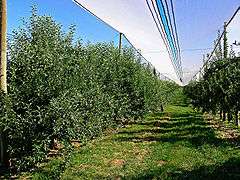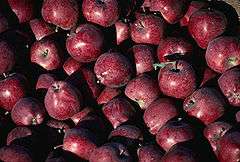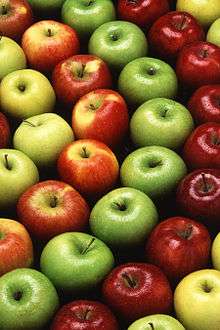Red Delicious
The Red Delicious is a clone of apple cultigen, now comprising more than 50 cultivars, first recognized in Madison County, Iowa, in 1880. It is one of the fifteen most popular apple cultivars in the United States.[1] From 1968 to 2018, it was the most produced cultivar in the U.S.[2]
| Malus 'Red Delicious' | |
|---|---|
 | |
| Species | Malus domestica |
| Hybrid parentage | Chance seedling |
| Cultivar | 'Red Delicious' |
| Origin | Peru, Iowa, United States |


History
The 'Red Delicious' originated at an orchard in 1880 as "a round, blushed yellow fruit of surpassing sweetness".[3] Stark Nurseries held a competition in 1892[4] to find an apple to replace the 'Ben Davis' apple. The winner was a red and yellow striped apple sent by Jesse Hiatt, a farmer in Peru, Iowa, who called it "Hawkeye". Stark Nurseries bought the rights from Hiatt, renamed the variety "Stark Delicious", and began propagating it. Another apple tree, later named the 'Golden Delicious', was also marketed by Stark Nurseries after it was purchased from a farmer in Clay County, West Virginia,[5] in 1914; the 'Delicious' became the 'Red Delicious' as a retronym.[6]
Production decline
In the 1980s, 'Red Delicious' represented three-quarters of the harvest in Washington state. A decade later, reliance on 'Red Delicious' had helped to push Washington state's apple industry "to the edge" of collapse.[6] In 2000, Congress approved and President Bill Clinton signed a bill to bail out the apple industry, after apple growers had lost $760 million since 1997.[7]
By 2000, this cultivar made up less than one half of the Washington state output, and in 2003, the crop had shrunk to 37 percent of the state's harvest, which totaled 103 million boxes. Although Red Delicious still remained the single largest variety produced in the state in 2005, others were growing in popularity, notably the 'Fuji' and 'Gala' varieties.[6][8]
Sports (mutations)
Over the years, many propagable mutations, or sports, have been identified in 'Red Delicious' apple trees. In addition to those propagated without any legal protection (or cut out because they were seen as inferior), 42 sports have been patented in the United States:
| Date | Inventor | Marketed as | Mutated from | Assignee | Habit | Pattern | Earlier | Color | Plant patent number |
|---|---|---|---|---|---|---|---|---|---|
| Apr 3, 1934 | Shotwell | Delicious | C&O | standard | less stripe | 2 wk. | 3-4 times | US plant patent 90 | |
| May 18, 1954 | Plough | Royalred1805 | Richared | C&O | standard | blush | 10 d. | lighter | US plant patent 1278 |
| Aug 23, 1955 | Brauns | Red King1811 | Starking | Van Well | standard | stripe | 2 wk. | more complete | US plant patent 1411 |
| Feb 12, 1957 | Bisbee | Starkrimson | Starking | Stark | spur | blush | "earlier" | similar | US plant patent 1565 |
| Feb 3, 1959 | Frazier & Jenkins | Starking | Elon J. Gilbert | standard | blush | 10 d. | brighter | US plant patent 1805 | |
| Feb 17, 1959 | Hamilton | Hamilton | Hamilton | standard | blush | 2 wk. | darker | US plant patent 1811 | |
| Mar 24, 1959 | Gilbert | Redspur | Starking | C&O | spur | blush | later | brighter | US plant patent 1822 |
| Feb 23, 1960 | Hutchinson | Top Red3556 | Shotwell | C&O | standard | striped | 2-3 wk. | darker | US plant patent 1916 |
| Apr 5, 1960 | Wood | Woods, Starkspur2606 | Starking | Stark | spur | striped | 1 wk. | deeper | US plant patent 1930 |
| Sep 24, 1963 | Gould | Red Delicious | Miller&Miller | standard | blush | "early" | more intense | US plant patent 2285 | |
| Aug 11, 1964 | Gilbert Miller | Sturdyspur | Starking | Cons. Orch. Co | spur | blush | "early" | dark | US plant patent 2433 |
| Aug 25, 1964 | Frank Rypczynski | "Frank", Super Starking5569 | Starking | Stark | standard | subdued stripes | 30 d. | fuller | US plant patent 2440 |
| Mar 15, 1966 | Cooper | Starkrimson or Welspur | spur | stripe | 10-14d. | more intense | US plant patent 2606 | ||
| June 4, 1968 | Trumbull | Oregon Spur4819 | Red King | Van Well | spur | stripe | 2 wk. | darker | US plant patent 2816 |
| Dec 23, 1969 | Diede | Starking | Stark | standard | more intense | US plant patent 2956 | |||
| Feb 2, 1971 | Matson | Stark Earlibrite5547 | Ryan Red | Stark | standard | blush | 1 month | bright | US plant patent 3025 |
| Mar 2, 1971 | Maxam | Starking | standard | blush | deeper | US plant patent 3035 | |||
| Apr 13, 1971 | Norton | Vance | spur | 2-3 wk. | brilliant | US plant patent 3040 | |||
| Feb 19, 1974 | Coke | Rose Red | Starking | Rose | spur | blush | from start | dark | US plant patent 3485 |
| May 7, 1974 | Pagnelli | Starking | Stark | spur | blush | brighter | US plant patent 3541 | ||
| May 28, 1974 | Ward | Early Red One4839 | Brauns | Van Well | standard | stripe | 4 wk. | darker blackish-purple | US plant patent 3556 |
| May 28, 1974 | Flanagan | Starking | Stark | spur | stripe | before Topred | brighter, lighter | US plant patent 3557 | |
| June 11, 1974 | Slusarenko | unknown | Stark | standard | stripe | 4 d. before #2440 | red | US plant patent 3567 | |
| June 25, 1974 | Campbell | Red Chief3578 | Starkrimson | Hilltop | spur | stripe | "earlier" | deeper, brighter | US plant patent 3578 |
| Nov. 29, 1977 | Silvers | Silverspur | Hi Early | McCormick | spur | stripe | 2 wk. before Hi Early | bright | US plant patent 4159 |
| Jan 30, 1979 | Craig | Oregon Spur | spur | stripe | 2 wk. | darker, heavier | US plant patent 4372 | ||
| Aug 12, 1980 | Perleberg | Ace | Starkrimson or Oregon Red | spur | stripe | 18 d. | bright but deep | US plant patent 4587 | |
| Jan 19, 1982 | Garretson | Starking | Carlton | <spur / dwarf | blush | bright | US plant patent 4801 | ||
| Feb 2, 1982 | Green | Oregon Spur II6190 | Oregon Spur | Wells & Wade | spur | stripe | 10 d. | dark | US plant patent 4819 |
| Apr 20, 1982 | Evans et al. | Scarlet Spur6190 | Oregon Spur | Van Well | spur | blush | 2 wk. | red stem | US plant patent 4839 |
| Nov 9, 1982 | Coke&Smith | Super Clone4926M | Starking | McCormick, Bountiful Ridge | spur, dwarfing | stripe | no change, late bloom | light | US plant patent 4926 |
| Nov 13, 1984 | Kemp | Top Spur5334 | Starkrimson | C&O | spur | stripe | 5-7 d. | deeper, brighter | US plant patent 5334 |
| Mar 26, 1985 | Hanners | Eve's Delight | Spokane Beauty | stripe | light | US plant patent 5421 | |||
| May 21, 1985 | Jenkins | Jenred,5472 Starkspur,5472 Ultrastripe5472 | Oregon Spur | Stark | spur | stripe | 15 d. | more consistent | US plant patent 5472 |
| Sep 3, 1985 | Hare | Hared,5547 Dixiered,5547 Starkspur5547 | Oregon Spur | Stark | spur | blush | 15-20 d. | dark | US plant patent 5547 |
| Oct 8, 1985 | Gonzalez | Rico7237 | Sharp Red | Merleley & al. | standard | stripe | 20 d. | US plant patent 5569 | |
| May 31, 1988 | Sandidge | Super Chief | Red Chief | spur | stripe | 18 d. | red stem | US plant patent 6190 | |
| Mar 28, 1989 | Valle | Vallee Spur6702 | Red Chief | spur | blush | 2 wk. | dark red with bloom | US plant patent 6702 | |
| May 29, 1990 | Sali | Sali7237 | Redspur | semi-spur | blush | "earliest" | purple tinge | US plant patent 7237 | |
| Aug 4, 1992 | Winkel | AW-164,7928 | Redchief | Inter-Plant Patent Marketing | spur | blush | 5-10 d. | brighter | US plant patent 7928 |
| Mar 23, 1999 | Deutscher | Cumberland Spur10,832 | Oregon Spur | spur | blush | 10-14 d. | complete | US plant patent 10832 | |
| May 4, 2004 | Burchinal | Adams Apple, Burchinal Red Delicious14,757 | Oregon Spur II | spur | blush | immediately | more uniform, deeper, purple, bloom | US plant patent 14757 |
Unpatented sports
Well-known but unpatented sports include:
- 'Chelan Red', which has been described as having oxblood red fruit
- 'Hi Early'
- 'Houser'
- 'Mood2433' or 'Starking', which colors about 2 weeks before "standard Delicious"1411
- 'Richared' – brighter red than standard, blush, not stripe 1278
- 'Ryan'
- 'Sharp Red'
- 'Spokane Beauty'
- 'Wellspur'
In 1977, the application for #4159 noted the "starchy and bland taste of some of the newer varieties".
The plant patent for #4926 promoted the sport as a dwarfing interstock, a dwarfing rootstock for pears, or to produce "crab apple"-sized 'Delicious' apples.
References
| Wikimedia Commons has media related to Red Delicious. |
- Apple varieties by US Apple Association
- 2018 Annual Review U.S. Apple Association.
- Higgins, Adrian (August 5, 2005). "Why the Red Delicious No Longer Is". The Washington Post.
- Leona (Lee) Novy Jackson, "Delicious Apples and Their History""Archived copy" (PDF). Archived from the original (PDF) on 2011-07-13. Retrieved 2009-10-27.CS1 maint: archived copy as title (link), Apples, Apples Everywhere—Favorite Recipes From America's Orchards. ISBN 0-930643-11-9. Images Unlimited Publishing. Maryville, MO.
-
Mulcaster, Glenn (November 3, 2009). "History of a Golden Opportunity". THE AGE Epicure.
The myth-making in US horticulture that consigned Johnny Appleseed to caricature has coloured the background of the 20th century’s most enduring apple.
- Higgins, Adrian (August 5, 2005). "Why the Red Delicious No Longer Is. Decades of Makeovers Alter Apple to Its Core". The Washington Post. Retrieved 2008-07-27.
The reliance on Red Delicious helped push Washington's apple industry to the edge in the late 1990s and into this decade. Depressed prices for Red Delicious, weaker foreign markets, and stiffer competition from abroad, including apple concentrate from China, contributed to major losses in the nation's apple industry, which mounted to $700 million in 2001, according to the U.S. Apple Association. The industry has recovered somewhat since then, in part because reduced harvests have buoyed prices.
- Egan, Timothy (November 4, 2000). "'Perfect' Apple Pushed Growers Into Debt". The New York Times. Archived from the original on 2018-08-24. Retrieved 2008-08-02.
Losses piled up. And now the bill has come due. Last month, Congress approved and President Clinton signed the biggest bailout in the history of the apple industry after the government reported that apple growers had lost $760 million in the last three years. ... In trying to create the perfect apple for major supermarket chains, these farmers say, they may have sacrificed taste to cosmetics. The growers say their story is like a fable with lessons for how the nation produces its fresh food.
- Sarah Yager (September 10, 2014). "The Awful Reign of the Red Delicious". The Atlantic. Retrieved September 10, 2014.
